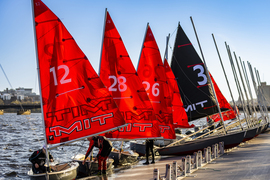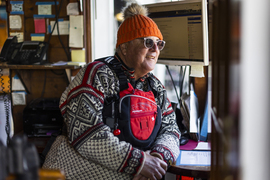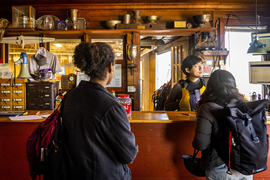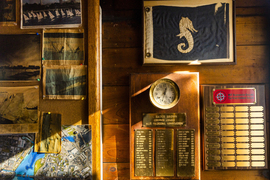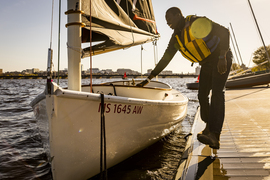There’s a long list of reasons why MIT’s sailing pavilion is unique. For one, it’s home to the oldest collegiate sailing program in the world. It’s also completely free and open to the MIT community — a rarity among sailing programs, made possible by alumni donations. There are also not many sailing facilities in the world that are regular sites for robot testing and other research.
The one thing everyone talks about, however, is the sailing pavilion’s atmosphere.
“We have a really calming vibe over here,” says Cucchiaro Family Sailing Master Fran Charles. “It’s a place where people can escape the stresses of academic life at MIT. That’s really important. It keeps people fresh. It’s a way to be with friends and have fun and be powered by nature.”
Each spring the sailing pavilion comes alive with a diverse mix of students, faculty, and alumni. They come to learn how to sail, race competitively, or just hang out on the docks. There’s also a surprising number of nonsailing activities that keep the pavilion busy. Researchers from across MIT use the pavilion to run experiments with robots and irrigation systems, and the pavilion’s large deck has been used for everything from movie shoots to weddings.
“We’re the front porch of campus,” says Associate Professor and Sail Coach Matthew Lindblad, who coaches MIT’s varsity sailing teams with Mike Kalin. “The venue really is a hub of activity. It’s a social, welcoming place. It’s got something for everyone to come and enjoy. An alum comes after 40 years and feels like they never left, but a student comes in every day and has a fun new adventure to find.”
Finding adventure
The MIT Sailing Pavilion was constructed in 1935 and first housed a string of single-mast, wooden tech dinghies. It served as the site of the first 10 dinghy championships of the recently formed college racing association, and today it still hosts more collegiate regattas than any other site in the country.
“Sailing was one of those sports for the wealthy, and MIT being the first university in the world to have sailing brought it to everyone, in little boats that offer a fun and exciting way to learn,” says Charles, who is retiring in June after 30 years at MIT. “We want to make sure sailing is accessible to all.”
MIT has two varsity sailing teams, one for women and another open to all students. The program, which is perennially ranked among the top 15 in the country, earned first place in the Women’s New England Championships this spring and last won the national championship in 2018.
“Our team has a tremendously supportive culture,” Lindblad says. “We compete as a team at the highest levels of college sailing nationally. The background of our team members covers a broad spectrum of experience levels, from people who had raced internationally as youth sailors to people who had never sailed before coming to MIT. All of those people play a role in our success.”
Senior Grace Mao was among those who had never sailed before coming to MIT from her home state of Kansas. She walked on to the sailing team and has since competed in national competitions. In the 2021-2022 season, Mao was named to the women’s all-conference team.
“The sailing team is a super tight-knit community, but it’s also super welcoming,” Mao says. “I didn’t have any problems walking on. Everyone was willing to help me.”
Although MIT’s varsity teams are well-known in the world of sailing, closer to campus the pavilion is better known for its recreational sailing program, which begins with its Learn to Sail classes. Each year, volunteers teach nearly 3,000 community members how to sail, after which they can access the pavilion seven days a week from April to November.
The pavilion offers tech dinghies with their distinctive red MIT sails, as well as vessels for hydro-foiling, wind surfing, cat boat sailing, and even bigger boats that can be taken into Boston Harbor.
The pavilion’s water access has also been tapped by a large group of researchers at MIT. There have been sea plane competitions held by the Department of Aeronautics and Astronautics, testing of water filtration systems by chemical engineering researchers, and near-daily robot navigation classes held for mechanical engineering students. One year, civil engineering students even built irrigation systems on top of the pavilion’s roof.
“There aren’t many campuses that are situated directly on the water, where you can actually do lab work and accomplish research right on campus, so it’s extremely convenient,” Charles says.
Memories that last a lifetime
There are plenty of stories of students meeting their significant others at the pavilion. Perhaps that’s why it’s become such a popular spot for weddings. Most of the time, however, the pavilion’s deck is hosting a lively function for one of MIT’s departments, labs, centers, or Greek life groups.
“I just love spending my free time at the pavilion,” Mao says. “You can make new friends you wouldn’t meet otherwise, the volunteers are super nice, and there’s always grilling happening. If you stick around long enough there’s even free food.”
Alumni also continue to play a prominent role at the sailing pavilion. They volunteer to teach learn to sail classes, return each year for the annual alumni regatta, or just stop by to soak up the memories.
“The sailing pavilion really hasn’t changed much over the years, it’s still super open and welcoming, and I love how most alumni come back and say it feels like it did when I was here,” Mao says. “It’s also great to hear stories from them, and just a great way to bridge communities among alumni.”
It’s possible the pavilion’s biggest impact is impossible to quantify.
“One of the best things about sailing — and everyone says this whether you talk to an alumn from 1945 or today — is that their time on the water completely cleared their head,” Lindblad says. “When people are out on the water, they can’t focus on anything else aside from the activity at hand, and it refreshes their mind, so when they came back to shore they have a completely different mindset — that, and the amazing sunsets!”

